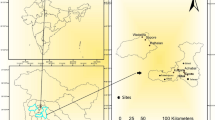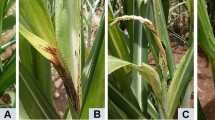Abstract
Rice is an important nutrient staple for much of the Turkish population. In this study, field surveys were carried out to collect isolates of Fusarium andiyazi, a member of the Fusarium fujikuroi species complex (FFSC) associated with Bakanae disease. As part of the study, morphological and microscopic features of Fusarium andiyazi isolates recovered from infected rice plants were determined. The molecular detection of F. andiyazi was carried out through PCR analysis of partial translation elongation factor 1-alpha (TEF-1α) gene and the internal transcribed spacer (ITS) region. Gib2 and Fgc primers were used for specific detection of strain of FFSC. In the phylogenetic analysis, using the sequences of the partial TEF-1α gene, F. andiyazi were clustered in the same branch with the reference isolates. The pathogenicity tests revealed that the isolates of F. andiyazi were pathogen on susceptible Baldo cultivar under room climate conditions. The disease severity ranged from 3.27% to 86.30%. The pathogen causes typical disease symptoms associated with Bakanae and mostly inhibited seed germination, while most of the isolates caused abnormal elongation compared to the control plants. This is the first report of presence of F. andiyazi causing Bakanae disease on rice in Turkey.




Similar content being viewed by others
Data Availability
All data during this study were included in this article.
Code Availability
Not applicable.
References
FAO (2019) Food and agriculture organization of the United Nations, http://faostat.fao.org Accessed 19 June 2020
Singh N, Devi RKT, Singh LNK (1996) Withering of groving shoot of rice caused by Fusarium. Plant Dis 11:2p
Batsa BK, Manandhar HK (1997) Rice disease situation in rice-wheat system in the mid-hills of Nepal. Proc. Int. Conf. Integr. Pl. Dis. Agric. Nov. 10-15-IARI, New Delhi, 456p.
Sun SK, Synder WD (1978) The bakanae disease of rice plant. Sci Bull Taiwan 10(7):2
Ou SH (1985) Rice diseases. 2nd Edition, Commonwealth Mycological Institue, Kew, Surrey, England, p 380
Desjardins AE, Manandhar HK, Plattner RD, Manandhar GG, Polıng SM, Maragos CM (2000) Fusarium species from Nepalese rice and production of mycotoxins and gibberellic acid by selected species. Appl Environ Microbiol 66(3):1020–1025. https://doi.org/10.1128/AEM.66.3.1020-1025.2000
Nakamura T, Mitsuoka K, Sugano M, Tomita K, Murayama T (1985) Effects of auxin and gibberellin on conidial germination and elongation of young hyphae in Gibberellaf ujikuroi and Penicillium notatum. Plant Cell Physiol 26:1433–1438p. https://doi.org/10.1093/oxfordjournals.pcp.a077044
Amoah BK, Rezanoor HN, Nıcholson P, Macdonald MV (1995) Variation in the Fusarium section Liseola: pathogenicity and genetic studies of Fusarium moniliforme Sheldon from different hosts in Ghana. Plant Pathol 44:569–572p. https://doi.org/10.1111/j.1365-3059.1995.tb01678.x
Wulff EG, Sorensen JL, Lubeck M, Nıelsen KF, Thrane U, Torp J (2010) Fusarium spp. associated with rice bakanae: ecology genetic diversity pathogenicity and toxigenicity. Environ Microbiol 12(3):649–657. https://doi.org/10.1111/j.1462-2920.2009.02105.x
Serefica K, Cruz, F (2009) Bakanae disease of rice a potential threat to the countrys rice supply. UPLB Research, Development and Extension News. 1–9p.
Mishra JK, Gergon E, Mew TW (1989) How long do fungal pathogens survive in rice seeds? Rice Seed Health News 1(1):6p
Dodan DS, Singh R, Sunder S (1994) Survival of Fusarium moniliforme in infected rice grains and its chemical control, Indian. J Mycol Plant Pathol 24:135–138p
Sunder S, Satyavir S (1997) Survival of Fusarium moniliforme in soil, grains and stubbles of paddy. Ind Phytop 51:47–50p
Zainudin NAIM, Razak AA, Salleh B (2008) Bakanae diseases of rice in Malaysia and Indonesia: etiology of the causal agent based on morphological, physiological and pathogenicity characteristics. J Plant Prot Res 48(4):476–485. https://doi.org/10.2478/v10045-008-0056-z
Pra MD, Tonti S, Pancaldi D, Nipoti P, Alberti I (2010) First report of Fusarium andiyazi associated with rice bakanae in Italy. Plant Dis 94(8):1070. https://doi.org/10.1094/PDIS-94-8-1070A
Choi HW, Hong SK, Lee YK, Kim WG, Chun S (2018) Taxonomy of Fusarium fujikuroi species complex associated with bakanae on rice in Korea. Aust Plant Pathol 47:23–34p. https://doi.org/10.1007/s13313-017-0536-6
Marley PS, Marasas WFO, Hester V (2004) Occurrence of Fusarium andiyazi associated with sorghum in Nigeria. Arch Phytopathol Plant Prot 37(3):177–181. https://doi.org/10.1080/03235400410001701667
Zidan L, Jawdat D, Naffaa W (2020) Morphology, pathogenicity and molecular identification of some Fusarium species within the Gibberella fujikuroi species complex from wheat in Syria. Curr Res Environ Appl Mycol (J Fungal Biol) 10(1):156–166p. https://doi.org/10.5943/cream/10/1/16
Zhang H, Luo W, Pan Y, Xu J, Xu JS, Chen WQ, Feng J (2014) First report of Fusarium ear rot of maize caused by Fusarium andiyazi in China. Plant Dis 98:10. https://doi.org/10.1094/PDIS-01-14-0038-PDN
Levya-Madrigal KY, Larralde-Corona CP, Apodaca-Sanchez MA, Quiroz-Figueroa FR, Mexia-Bolanos PA, Portillo-Valenzuela SP, Ordaz-Ochoa J, Maldonado-Mendoza IE (2015) Fusarium species from the Fusarium fujikuroi species complex involved in mixed infections of Maize in Northern Sinaloa, Mexico. J Phytopathol 163:486–497p. https://doi.org/10.1111/jph.12346
Venturini G, Toffolatti SL, Quaglino F, Casati P (2017) First report of Fusarium andiyazi causing ear rot on maize in Italy. Plant Dis 101:5. https://doi.org/10.1094/PDIS-10-16-1525-PDN
Leslie JF, Summerell BA (2006) The Fusarium labaratory manual. Blackwell Publishing Ltd, UK
O’Donnel K, Cıgelnik E, Nırenberg HI (1998) Molecular systematics and phylogeography of the Gibberella fujikuroi species complex. Mycologia 90:465–493. https://doi.org/10.1080/00275514.1998.12026933
Skovgaard K, Nirenberg ILL, O’Donnell K, Rosendah IS (2001) Evolution of Fusarium oxysporium f. sp. vasinfectum races inferred from multigene genealogies. Phtyopathology 91:1231–1237. https://doi.org/10.1094/PHYTO.2001.91.12.1231
Mule G, Suscca A, Stea G, Morettı A (2004) A species-specificc PCR assay based on the calmodulin partial gene for the identification of Fusarium verticillioides, Fusarium proliferatum, Fusarium subglutinans. Eur J Plant Path 100:495–502p. https://doi.org/10.1023/B:EJPP.0000032389.84048.71
Quazi SAJ, Meon S, Jaafar H, Ahmad ZABM (2013) Characterization of Fusarium proliferatum through species specific primers and its virulence on rice seeds. İnt J Agric Biol 15:12–1354
Costa MM, Melob MP, Guimar~aesa EA, Veigaa CMO, CarmoSandina F, Moreirac GM, Costaa SS, Pfenning LH (2019) Identification and pathogenicity of Fusarium species associated with pokkah boeng of sugarcane in Brazil. Plant Pathol. https://doi.org/10.1111/ppa.13053
Aboul-Nasr MB, Abdul-Rahman MR (2014) A simple technique for single spore isolation of Fusarium verticillioides and Fusarium subglutinans. World J Biol Biol Sci 2(1):21–25p
Nirenberg HI, O’Donnel K (1998) New Fusarium species and combinations within the Gibberella fujikuroi species complex. Mycologia 90:434–458. https://doi.org/10.1080/00275514.1998.12026929
Townsend GK, Heuberger JW (1943) Methods for estimating losses caused by diseases in fungicide experiments. Plant Dis Reptr 27:340–343
White TJ, Bruns TD, Lee SB, Taylor JW (1990) Amplification and direct sequencing of fungal ribosomal RNA genes for phylogenetics. In: Innis MA, Gelfand DH, Sninsky JJ, White TJ (eds) PCR protocols: a guide to methods and applications. Academic Press, New York, pp 315–322
Jurado M, Vazguez C, Marın S, Sanchıs V, Gonzalez-JAen T (2006) PCR based strategy to detect contamination with mycotoxigenic Fusarium species in mazie. Syst Appl Microb 29:681. https://doi.org/10.1016/j.syapm.2006.01.014
Amatulli MT, Spadaro D, Gullıno ML, Garibaldi A (2010) Molecular identification of Fusarium spp. associated with bakanae disease of rice in Italy and assesment of their pathogenicity. Plant Pathol 59:839–844. https://doi.org/10.1111/j.1365-3059.2010.02319.x
Singha IM, Kakoty Y, Unni BG, Das J, Kalita MJ (2016) Identification and characterization of Fusarium sp. using ITS and RAPD causing fusarium wilt of tomato isolated from Assam, North East India. J Genet Eng Biotechnol 14:99–105. https://doi.org/10.1016/j.jgeb.2016.07.001
Kumar S, Stecher G, Tamura K (2016) MEGA7: molecular evolutionary genetics analysis version 7.0 for bigger datasets. Mol Biol Evol 33:1870–1874. https://doi.org/10.1093/molbev/msw054
Nei M, Kumar S (2000) Molecular evolution and phylogenetics. Oxford University Press, New York
Felsenstein J (1985) Confidence limits on phylogenies: an approach using the bootstrap. Evolution 39:783–791
Eğerci Y, Kınay-Teksür P, Uysal-Morca A (2020) First report of rice bakanae disease caused by Fusarium fujikuroi Nirenberg in Turkey. J Plant Pathol. https://doi.org/10.1007/s42161-020-00604-4
Geiser DM, Jımenez-Gasco MM, Kang S, Makalowska I, Weeraraghavan N, Ward TJ, Zhang N, Kuldau GA, O’Donnell K (2004) Fusarium ID, DNA sequence database for identfying Fusarium. Eur J Plant Pathol 110:473–479p. https://doi.org/10.1023/B:EJPP.0000032386.75915.a0
Hsuan HM, Salleh B, Zakaria L (2011) Molecular identification of Fusarium species in Gibberella fujikuroi species complex from rice, sugarcane and maize from Peninsular Malaysia. Int J Mol Sci 12:6722–6732. https://doi.org/10.3390/ijms12106722
Yu JM, Babadoost M (2013) Occurrence of Fusarium commune and F. oxysporum in horseradish roots. Plant Dis 97:453–460. https://doi.org/10.1094/PDIS-06-12-0538-RE
Al-Hatmi AMS, Mirabolfathy M, Hagen F, Anne-Cécile N, Benjamin Stielow J, Karami-Osbo R, Van Diepeningen AD, Meis JF, Sybren de Hoog G (2015) DNA barcoding MALDI-TOF and AFLP data support Fusarium ficicrescens as a distinct species within the F fujikuroi species complex. Fungal Biol. https://doi.org/10.1016/j.funbio.2015.08.001
Pena GA, Cavaglieri LR, Chulze SN (2019) Fusarium species and moniliformin occurrence in sorghum grains used as ingredient for animal feed in Argentina. J Sci Food Agric. https://doi.org/10.1002/jsfa.9140
Camila PN, Miriam H, Antonia S, Larissa BG, Antonio L, Gaetano S, Emerson MDP, Antonio M, Ludwig HP (2020) Fusarium fujikuroi species complex in Brazilian rice: unveiling increased phylogenetic diversity and toxigenic potential. Int J Food Microbiol 330:108667. https://doi.org/10.1016/j.ijfoodmicro.2020.108667
Ezekiel CN, Kraak B, Sandoval-Denis M, Sulyok M, Oyedele OA, Ayeni KI, Makinde OM, Akinyemi OM, Krska R, Crous PW, Houbraken J (2020) Diversity and toxigenicity of fungi and description of Fusarium madaense sp. nov. from cereals, legumes and soils in north-central Nigeria. MycoKeys 67:95–124. https://doi.org/10.3897/mycokeys.67.52716
Isaac MR, Leyva-Mır SG, Sahagun-Castellanos J, CamarA-Correıa K, Tovar-Pedraza JM, Rodrıguez-Perez JE (2018) Occurrence identification, and pathogenicity of Fusarium spp. associated with tomato wilt in Mexico. Not Bot Horti Agrobot 46(2):484–493. https://doi.org/10.1835/nbha46211095
Madania A, Altawil M, Naffaa W, Volker PH, Hawat M (2013) Morphological and molecular characterization of Fusarium isolated from maize in Syria. J Phytopathol 161(7–8):452–458. https://doi.org/10.1111/jph.12085
Acknowledgements
This work is a part of PhD study. The authors acknowledge the Ministry of Agriculture and Forestry for kindly supporting the project and also thankful to Directorate of Plant Protection Research Institute for technical support.
Funding
This study was supported by Ministry of Agriculture and Forestry, Republic of Turkey (TAGEM-BS-15/12-04/02-09).
Author information
Authors and Affiliations
Contributions
Conception and design and critical revision of the manuscript for important intellectual content: YE and AUM. Data acquisition and interpretation: YE, PKT, and AUM. Coordination of the research project: PKT. Technical and material support: YE, PKT, and AUM. All authors read and approved the final manuscript.
Corresponding author
Ethics declarations
Conflict of interest
The authors declare that they have no conflict of interest.
Ethical Approval
The manuscript does not contain experiments involving animal or human studies and is approved by all authors.
Consent for Publication
Not applicable.
Consent to Participate
The manuscript does not contain experiments involving animal or human studies and is approved by all authors.
Additional information
Publisher's Note
Springer Nature remains neutral with regard to jurisdictional claims in published maps and institutional affiliations.
Rights and permissions
Springer Nature or its licensor holds exclusive rights to this article under a publishing agreement with the author(s) or other rightsholder(s); author self-archiving of the accepted manuscript version of this article is solely governed by the terms of such publishing agreement and applicable law.
About this article
Cite this article
Eğerci, Y., Teksür, P.K. & Morca, A.U. Identification of Fusarium andiyazi Associated with the Bakanae Disease of Rice in Turkey. Curr Microbiol 79, 291 (2022). https://doi.org/10.1007/s00284-022-02962-x
Received:
Accepted:
Published:
DOI: https://doi.org/10.1007/s00284-022-02962-x




